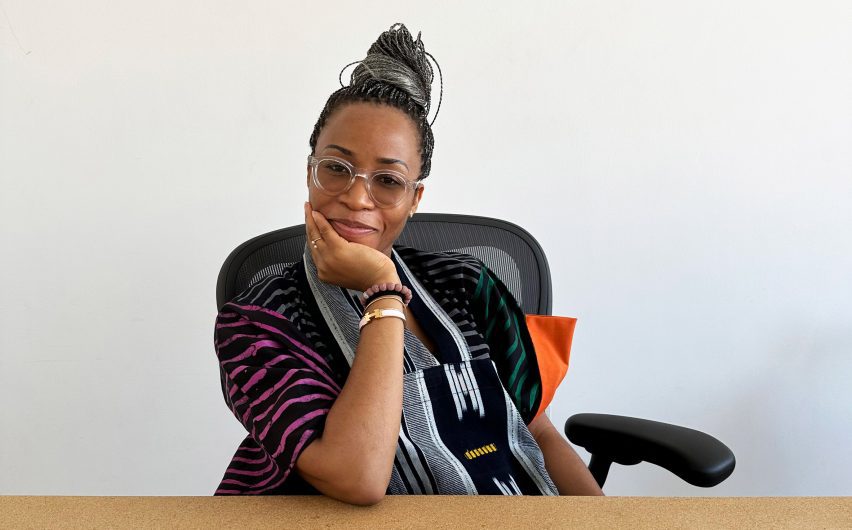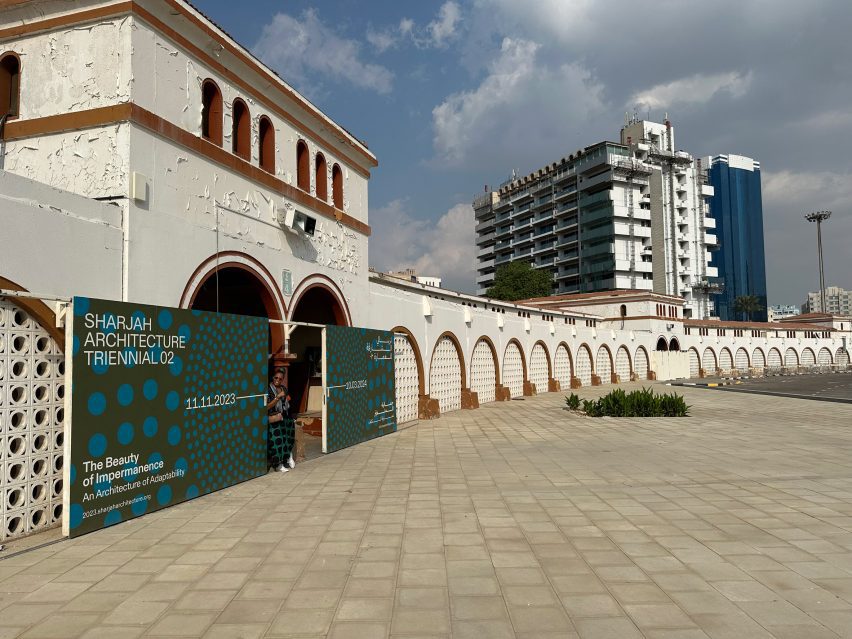
Sharjah triennial rethinks architecture that "results from conditions of scarcity" says Tosin Oshinowo
The Sharjah Architecture Triennial aims to show the positives of architecture created using scarce resources, says its curator Nigerian architect Tosin Oshinowo in this interview.
Titled The Beauty of Impermanence: An Architecture of Adaptability, the triennial focuses on the innovations and strategies of re-use and re-appropriation often driven by scarcity in the Global South.
"The triennial is looking at the under-celebrated building innovations and designs that tend to still exist within the Global South and that result from conditions of scarcity," Oshinowo told Dezeen.
"There's also re-teaching, or reminding people in the Global South, that what we may not have considered as valuable or essential or even positive, actually has been," she continued.
"So it's also making the Global South realise and re-evaluate itself and optimistically position that we're not in a bad place."
"I'm ultimately looking at what lessons we can learn"
Many of the installations, which have been designed by studios including Cave Bureau, Wallmakers, Asif Khan, 51-1 Arquitectos and Formafantasma, focus on architecture that was designed utilising the locally available materials and skills that constrained building practices.
However, Oshinowo was keen to find people working within contemporary situations where wider lessons can be learnt.
The majority of the participants are from the Global South with around 30 per cent from Africa, 30 per cent from South America and 15 per cent from the Gulf region.
"What's been really exciting is finding people whose work resonates around these things, but who are existing within a modern context," she said.
"I'm ultimately looking at what lessons we can learn from these circumstances, particularly as a lot of the locations where these practices exist are also able to work better with the environment – when you work with limited resources you can coexist in balance with ecology."
"We need to rethink what we consider as progress"
Along with those in the Global South re-assessing the value of local processes, Oshinowo believes that we should reconsider what we think of as progress.
And that those in the Global North can also learn from the examples in the triennial.
"I think it's important for us to now question what is what is seen as progress," she said.
"Everyone's model is this Global North attainment – this is how it's done, this is how we need to develop, this is how we need to live, this is how we need to dress – but why this reference, this single reference? Maybe then we need to rethink what we consider as progress."
"We need to think, what can we learn from these southern regions?" she continued. "How can we be in better balance with our environments?"

Through the installations, she hopes visitors to the triennial will rethink how they currently practice and see the potential of operating in a variety of ways.
"There are two things that I would really like people to take away," she said. "One – to see the diversity of solutions that can exist or do exists, and functioning and thriving in specific locations."
"And, I would like people to take away an awareness of the challenges that our current model of progress and consumption and the implication has on the climate," she continued. "Within that, I hope people see the possibilities of how, as individuals and practitioners, we could potentially have a change of mindsets and how we practice and how we train."
"We wanted to very obviously include architecture"
To convey this message, Oshinowo aimed to make the triennial as accessible as possible by including numerous, full-scale works built especially for the event, believing that "only architects read text".
Asked if Zaha Hadid Architects principal Patrik Schumacher, who was very critical about the content of this year's Venice Architecture Biennale, would be happy with what is included in the event, she said there was a conscious effort to include actual examples of architecture.
"We wanted to very obviously include architecture and very obviously include architecture that is about experimentation," she said.
"The mediums that we are using to share information are about experience," she continued. "There's no project here that is pinned up drawings – we have quite a few installations, we do have some films, but we also have built projects and built projects that are about experience."
She believes that this approach will mean that the triennial and its exhibits will be broadly understood by visitors and locals from Sharjah and the UAE.
For anyone who's not an architect, the experience of being in the exhibit, how it makes you feel, what you see, how your senses are evoked, is very important, because that's what you remember," she explained.
"If a 15-year-old comes to this exhibition, there will be certain things that they will see that they will say, I really like Yussef Agbo-ola's work – it's a temple, which is in celebration of ecology and the natural environment."
"We've created the problem, but we also part of the solution"
Overall she hopes that the triennial will send a positive message by drawing attention to practices that may offer some solutions to the climate crisis.
"Apparently, this year is the hottest in human history – so, you know, it's not great, and it's based on all the decisions that we all make," she said.
"So I hope that by seeing some of the possibilities and solutions that exist and understanding the wider narratives that are based on limits where people are able to function and thrive, people can leave with an optimism – we've created the problem, but we are also part of the solution."
The second Sharjah Architecture Triennial was originally scheduled to take place in 2022 but, like numerous design events, was delayed as a result of Covid-19 uncertainty. It follows the inaugural event in 2019 that saw installations from Marina Tabassum and Cooking Sections.
The photography is by Tom Ravenscroft.
Sharjah Architecture Triennial 2023 takes place from 11 November 2023 to 10 March 2024 at various locations across Sharjah. See Dezeen Events Guide for an up-to-date list of architecture and design events taking place around the world.